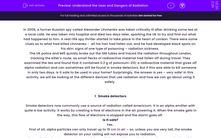In 2006, a former Russian spy called Alexander Litvinenko was taken critically ill after drinking some tea at a local café. He was taken into hospital and died two days later, sparking the UK to try and find out what had happened to him. A real-life spy thriller started to take place in the heart of London. There were some clues as to what had killed Litvinenko - all his hair had fallen out, and he had developed black spots on his skin: signs of one type of poisoning – radiation sickness.
The UK police and MI5 quickly broke out the GM tubes and traced the radiation throughout London, tracking the killer’s route, as small flecks of radioactive material had fallen off during travel. They examined the tea and found that it contained 0.2 g of polonium-210, a radioactive material that gives off alpha radiation and can sometimes still be found in smoke detectors. But if this was able to kill someone in only two days, is it safe to be used in your home? Surprisingly, the answer is yes – very safe! In this activity, we will be looking at the different devices that use radiation and how we can go about using it safely.
1 Smoke detectors
Smoke detectors now commonly use a source of radiation called americium. It is an alpha emitter with quite a low activity. It works by creating a flow of electrons in the air powering it. When the smoke gets in the way, this flow of electrons is stopped and the alarm goes off.
Is it safe?
Yes.
First of all, alpha particles can only travel up to 15 cm in air – so, unless you are very tall, the smoke detector on your ceiling will not expose you to radiation.
Secondly, it only takes paper to stop alpha radiation, and the smoke detector is surrounded by thick layers of plastic.
Thirdly, it is only dangerous to you if you get it inside your body – so don’t eat your fire alarm.
Finally, is it safer to have a low emitter of radiation in your house that cannot cause you any harm, or no smoke detector? Think about the benefits of having a smoke detector versus the risk of the radiation – which would you prefer?
2 Measuring the thickness of metal sheets
Beta particles are used for measuring the thickness of metal sheets during their manufacture. It makes sure that the sheets don’t get too thick or too thin so they can be used for their intended purpose. There is a detector on one side of the metal and a source of radiation on the other. If the sheet gets too thick, the count will go down and the rollers will get thinner. If the sheet is too thin, the count will go up and the rollers will have to get further apart.
Is it safe?
Most of the time.
There are strict controls about how close people can get to the radiation. It is shielded by thick metal and checked for leaks regularly, and only trained people who wear radiation metres are allowed close to it. It’s not going to explode, but you don’t want to increase the risk of people being exposed to it more than they have to be.
3 Killing cancer
Gamma rays are used to destroy tumours in hard to reach places. That’s right, something that can cause cancer is also used to kill it. You sit in a machine and are pinned in place so that you cannot move. The machine then shoots gamma radiation at you from lots of different angles. This makes sure that the tumour has the largest dose of radiation and the area around the tumour is kept healthy. Patients are normally given 15 grays of radiation (1 gray is enough to instantly kill a human) but it is carefully targeted so that it only kills the tumour.
Is it safe?
No.
You are receiving 15 times the amount of radiation that can kill a person, of course it is not safe. You have a chance of getting other cancers from doing this procedure!
Why do we do it then?
Because it is worth the low risk of maybe getting another cancer in order to kill the cancer that you currently have. This type of therapy is generally used as a last resort because of the risks that come with it, but it will give the patient extra years on their life.
What do you think – do the benefits of the radiotherapy outweigh the risks?
Let's have a go at some questions.








